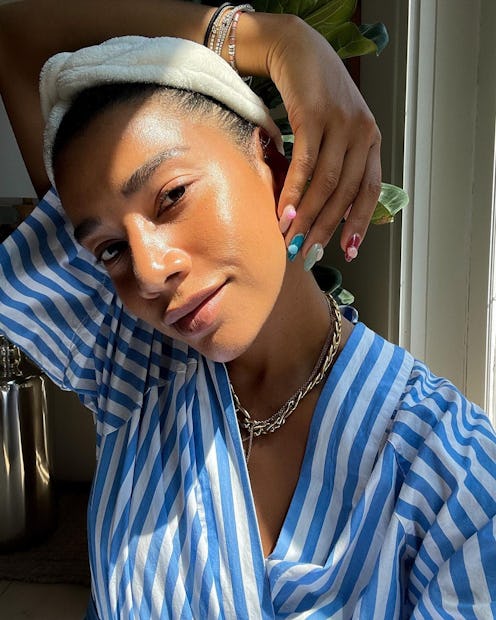(Skin)
Let’s Debunk The “Two Finger” SPF Rule, Once & For All

According to the American Academy of Dermatology, skin cancer is the most common cancer in the United States with an estimated 9,500 people diagnosed with the condition every single day. And while many of us think that we're properly protecting ourselves from the effects of UV rays with our daily dime-sized amount of SPF, that's not even close to enough. So how much SPF do we need? According to the experts, you're probably not using enough.
Read more: 20 Sunscreens For Mature Skin That Derms Can’t Stop Recommending
"Sunscreens are needed because they protect the skin from harmful UV rays that cause skin damage and accelerate aging," Dr. Kim Nichols, MD, a board-certified dermatologist and SkinCeuticals Partner Physician, tells TZR. "Beyond the adverse effects of aging, SPF also protects against adverse health conditions including skin cancer." But with such responsibility falling on the essential skincare product, the amount required is more than, say, our daily moisturizer. "According to the American Academy of Dermatologists, most adults do not apply enough sunscreen, with the majority of people only applying 25 percent to 50 percent of the proper amount," Dr. Nichols says. What's adequate, she says, is a whopping one ounce — or the equivalent of a shot glass — for face and body combined.
When speaking solely about the face, however, Tiara Willis, esthetician and founder of social media platform Makeup For WOC recently shared on Twitter with her 250,000 Twitter followers that adults should be using two fingers' worth of SPF to adequately benefit and protect their skin. The amount startled her Twitter feed, with Willis receiving over 10,000 responses to the tweet. However, her advice isn't particularly new. The "rule," which stems from a 2002 study by a group of New Zealand doctors, was developed from the fingertip used in skincare which measures the amount of cream or ointment to be used in dermatology.
And while many of Willis' followers admitted being hesitant to try the rule, afraid of their skin becoming too oily, others dove right in. "Ever since people started applying two fingers of SPF, I’ve gotten hundreds of tweets saying they’re already seeing results in their hyperpigmentation, dark circles, texture and even acne," Willis tells me. She insists that the rule applies to both lighter and darker skin. "Information regarding skincare for Black skin isn’t easily accessible, so it’s very rewarding seeing so many Black women achieve their skincare goals."
To see the best results, Dr. Nichols suggests applying SPF in the morning at least 20 minutes before sun exposure so that it has time to absorb into the skin. "I recommend applying after a moisturizer, and before makeup," she says. "Additionally, if you are planning on spending the day outside, remember to bring your sunscreen with you to reapply every two hours for proper protection."
And both Nichols and Willis agree that the same amount is needed in the fall and winter, too. "There are two types of UV rays: UVA rays and UVB rays," Dr. Nichols says. "The shorter UVB rays are what causes sunburns, and they dwindle in the colder months as they are less able to cut through clouds and reach the Earth’s surface. However, the longer UVA rays persist all year, and actually penetrate deeper into the skin to cause the dark spots and wrinkles associated with sun damage. By continuing to wear your SPF all year round, you’ll protect your skin and more effectively prevent common signs of aging." And if you're in an area with blistering winters, you should be extra cautious. "UV always reflects off of snow, making it more intense," Willis says.
We only include products that have been independently selected by The Zoe Report's editorial team. However, we may receive a portion of sales if you purchase a product through a link in this article.
This article was originally published on